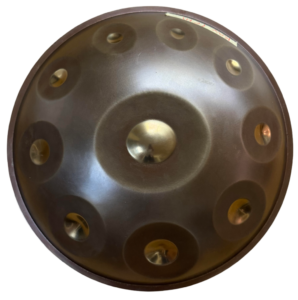Exploring the Anatomy and Playability of the Handpan
Handpans are unique musical instruments that captivate with their ethereal sounds, making them popular among musicians and music therapists alike. Understanding the structure of a handpan and learning the basics of playing it can significantly enhance your musical journey. Let’s dive into the details.
The Anatomy of a Handpan
A handpan may appear simple, but it is a highly intricate instrument with several essential components:
The Ding (Central Tone Field):
- At the heart of the handpan is the central tone field, commonly known as the ding. The ding is the primary note, usually in a convex dome shape, which produces the fundamental tone when struck. The other notes have usually a concave form, which is called a dimple. Still both the ding and dimple can have sometimes the opposite forms too.
- The area surrounding the note, as well as the ding, is called the tone field, where different notes are precisely tuned to create harmonious melodies. Each tone field can resonate with multiple harmonics, including the fundamental note, its octave, and the fifth. (This is for every note) These other notes surrounding the ding are sometimes called the note circle. The surrounding notes usually consist of a dimple, a tone field and also a note border.
Note Borders and Interstitials:
- Surrounding each tone field is the note border, which has its own distinct percussive quality. This border helps in producing unique sounds that differ from the main tones.
- The interstitials are the spaces between the tone fields. These areas are structurally stronger and can be used for percussive strikes without disrupting the tuning of the instrument. The careful design of these spaces ensures that the handpan remains resilient and musical.
The Port/ The Gu (Helmholtz Resonator):
- On the underside of the handpan, there is an opening known as the port or goo, which contributes to the bass tones. The design of this port, including its size and the shape of the surrounding neck, influences the depth and resonance of the bass sound, often referred to as the Helmholtz resonance.
Getting Started with Handpan Playing
For beginners, the key to mastering the handpan lies in understanding its structure and starting with simple techniques:
- Multiple Fingers Technique: Use various fingers, including thumbs and index or middle fingers, to explore the range of sounds produced by the different tone fields.
- Exploring Tone Fields: Gently strike the tone fields to find the sweet spots where harmonics are most prominent, gradually learning to combine these tones into simple melodies.
- Percussive Play: The note borders and interstitials offer a wealth of percussive possibilities, allowing you to add rhythm and texture to your music.
Conclusion
Mastering the handpan begins with a deep understanding of its anatomy and the development of basic playing techniques. Whether you’re playing for personal enjoyment, meditation, or performance, the knowledge of these components will enhance your ability to create beautiful, harmonious music. As you progress, consider exploring advanced techniques and participating in workshops to refine your skills further.
In this video we show you how to build a handpan. Get inspired by Rafael and his team. Take a look at our beautiful instruments here.





